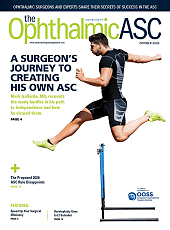While artificial intelligence (AI) solutions such as AI scribes, telephone systems, and claims scrubbing have increased administrative efficiency for many practices, AI can also help ophthalmologists make more informed diagnoses and medical decisions, ultimately leading to improved patient outcomes. This is particularly apparent in imaging analysis, where AI platforms can process large quantities of data faster, more accurately, and in greater detail than even the most astute physician can. Here, we take a look at some of these platforms.
AI Decision Support for OCT
Launched in 2019, AI Decision Support (Altris AI) is a web platform for automated optical coherence tomography (OCT) analysis that compares retinal scans across 8 vendor platforms, detecting the presence or absence of retinal disease and glaucoma without the need for a targeted search, according to the manufacturer. It begins by identifying nonpathologic OCT scans and removing them from the pool, then it analyzes the remaining images for 70-plus retinal pathologies and biomarkers, including geographic atrophy, diabetic retinopathy, drusen, tapetoretinal degeneration, and macular telangiectasia type 2.1
AI Decision Support also features a glaucoma early-risk assessment module, which combines ganglion cell complex (GCC) analysis and advanced optic disc (OD) analysis for signs of structural damage. The module integrates with OCT systems to evaluate the macula cup-to-disc ratio as well as the area, volume, and depth of the disc and cup, then calculates a severity score for optic disc damage.1
For both retinal disease and glaucoma, AI Decision Support assesses the patient’s risk and the severity of the pathology through quantitative tracking of disease progression. This information can influence treatment decisions and assist the clinician in making a differential diagnosis.1
“At Altris AI, we are thrilled to introduce a new way of working with OCT: faster, more informative, and with more control,” commented Altris AI medical director Maria Znamenska, MD, PhD, in a news release. “Our team of retina experts and IT specialists has worked tirelessly to develop cutting-edge technologies that will set higher standards in the eye care industry and improve patient outcomes as a result.” 1
Altris AI continues to roll out new software. In July, the company introduced Altris Sync, an application that automatically and securely uploads files from a physician’s device directly to OCT units. In September, it added an advanced flagging system to its OCT scan database to facilitate searches for specific pathologies.2
GenA Eye
In February, at Vision Expo East in Orlando, Florida, Oculogyx officially launched its GenA Eye suite of AI-based ophthalmic tools for improving diagnostic accuracy and enhancing practice efficiency. The company reports that its GenA Eye Powered Image Analysis system, with a vast database to learn from, employs advanced algorithms to more precisely interpret visual fields, retinal photography, optic nerve OCT, and corneal topography for informed clinical decision-making.3
“Oculogyx was founded with a vision to empower eye care providers through AI technology,” the company’s chairman, David Schanzlin, MD, stated in a press release. “Our AI-powered suite allows doctors to focus more on patient care and less on administrative burdens.” 3
CIRRUS PathFinder
In August, Zeiss Medical Technology announced that it had been granted CE mark approval for the CIRRUS PathFinder, an AI-based software tool that integrates with CIRRUS 500, 5000, and 6000 for advanced OCT report interpretation.4 As of press time, the PathFinder is not yet approved for use in the United States, so consider the following a preview.
According to Zeiss, PathFinder uses proprietary deep-learning algorithms to automatically identify and flag abnormal macular OCT-B scans and enhance the quality of OCT-A images for better visualization of the vascular structure. The system’s AI software is fully integrated into the clinician’s current workflow, facilitating the efficient assessment of hundreds of scans at once. 4
“The AI decision-support capabilities of Zeiss CIRRUS PathFinder help enable faster, more informed, and actionable diagnostics for a better clinical and patient experience,” Magnus Reibenspiess, head of the ophthalmology strategic business unit at ZEISS Medical Technology, stated in a press release. 4
SCANLY Home OCT and Notal OCT Analyzer
Also in August, Notal Vision published results from a study of 180 wet AMD patients demonstrating that its AI-based Notal OCT Analyzer (NOA) can accurately track retinal disease. Using images captured daily by patients with Notal’s SCANLY Home OCT, the NOA estimates disease biomarkers and plots measurements over time, allowing physicians to monitor disease progression or response to therapy.5-7
“Home OCT-based monitoring has been validated in large pivotal trials with over 500 patients, which is rare for medical imaging technology,” said Dr. Theodore Leng, director of clinical and translational research and ophthalmic diagnostics at Stanford’s Byers Eye Institute, in a press release. “Our study went a step further by showing that home OCT longitudinal data trajectories are clinically valuable and essential in helping retina specialists personalize disease management.” 5-7
This study follows the February 2025 publication of an earlier pivotal study of 336 wet AMD patients using the SCANLY Home OCT and NOA, which led to the first US Food and Drug Administration clearance of an AI
algorithm applied to OCT images.6-7 OM
References
1. “AI-Powered OCT Analysis.” Altris AI; 2025. Press release. Available at: https://www.altris.ai/press-kit/ [Accessed August 26, 2025]
2. “Altris AI Launches Altris Sync App Allowing AI to Directly Sync to OCT Devices.” Altris AI; 2025. Press release. Available at: https://eyewire.news/news/altris-ai-launches-altris-sync-app-allowing-ai-to-directly-sync-to-oct-devices-ai-now-connects-to-oct-devices-from-8-manufacturers-and-enables-analysis-of-historical-data?c4src=article:infinite-scroll [Accessed July 31, 2025]
3. “Oculogyx Unveils Cutting-Edge AI Solutions for Eye Care Providers at Vision Expo East 2025.” Gen A Eye; 2025. Press release. Available at: https://www.oculogyx.ai/ [Accessed February 18, 2025]
4. “ZEISS Announces CE Mark for CIRRUS PathFinder AI Tool With Automated
OCT Assessment.” ZEISS; 2025. Press release. Available at: https://pub-mediabox-storage.rxweb-prd.com/exhibitor/document/exh-e15cbe66-6925-47bb-a1a4-3eb10559579a/b7408dcc-b758-435d-af9e-61700e7b708e.pdf [Accessed August 21, 2025]
5. “AI Turns Daily Home OCT Images into Actionable Disease Insights for Retina Specialists.” Notal Vision; 2025. Press release. Available at: https://notalvision.com/news/press-releases. [Accessed August 26, 2025]
6. “Pivotal Study Demonstrates Efficacy of AI in enabling Home OCT Monitoring.” Notal Vision, 2024. Press release. Available at: https://notalvision.com/news/press-releases. [Accessed August 26, 2025]
7. Schneider EW, Heier JS, Holekamp NM, et al. Pivotal trial toward effectiveness of self-administered OCT in neovascular age-related macular degeneration. Report 2-artificial intelligence analytics. Ophthalmol Sci. 2024;5(2):100662. doi:10.1016/j.xops.2024.100662









